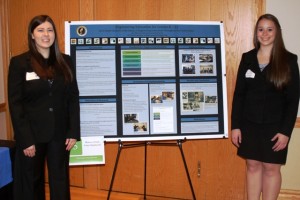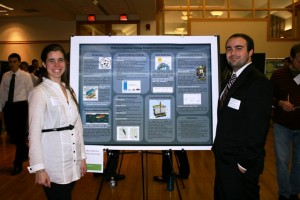Through hands-on collaboration, students in chemistry and engineering classes have teamed up to complete comprehensive research focusing on environmental science.

Laura Spadaccini ’14 and Rebecca Citrin ’14 with their research entitled Engineering Education for Grades K-12
The unique approach combines the Environmental Science and Engineering course taught by Arthur Kney, associate professor and head of civil and environmental engineering, and Environmental Chemistry, taught by Steven Mylon, associate professor of chemistry and chair of environmental science and studies. Students in the two courses came together in groups of two or three to research and explore environmental topics of their choice.
Kney says, “Both classes have the similar theme of environmental science, but each is taught from the perspective of our specific disciplines, engineering and chemistry. As students consider projects, work on projects, and exchange ideas they are surprised to find that many of the topics we talk about are the same, but presented from different perspectives. They are then able to begin making connections to these and other classes that have similar themes and better utilize the information in productive ways.”
This project “lends itself to collaborative work because students develop a poster on a topic of their choosing throughout the entire semester and they do it outside of regularly scheduled class meetings.”
Each group had the opportunity to present its findings at the Environmental Poster Presentation in December. This year’s poster session showcased 28 posters judged by a collection of professionals from the Lehigh Valley along with students who previously took one of the courses.

Ashley Kaminski '13 and Rich Albertini ’13 with their project Methane Hydrates: Energy Solution or Environmental Hazard!
Mylon says, “Professor Kney and I have worked together on many things over the past eight years. We have worked on research projects together, co-advised Society of Environmental Engineers and Scientists, and a number of other things. This seemed like a natural way to bridge our two classes.”
Civil engineering majors Rebecca Citrin ’14 (Springfield, N.J.) and Laura Spadaccini ’14 (Oradell, N.J.) researched engineering education for grades K-12. The pair analyzed the state of engineering curriculum throughout the United States. As part of their project, the students organized the first Lafayette College Engineering Brain Bowl. Approximately 35 students from Northampton County attended the event, where they participated in interactive hands-on activities and Lafayette faculty presented information based on their respective area of expertise.
At the end of the event, Citrin and Spadaccini used a survey to determine what knowledge the students gained. “The event was successful in that we were able to bring exposure to the importance of studying engineering in primary and secondary schools through educational activities,” says Citrin. “Through our findings we were able to identify the importance of implementing engineering-based programs for students from grades K-12, who will not only benefit academically from this early exposure to engineering, but will also gain valuable life skills.”
Chemistry majors Rich Albertini ’13 (Sussex, N.J.) and Ashley Kaminski ’13 (Springfield, Pa.) studied methane and whether it could be safely harvested from the deep sea and permafrost regions. This would allow natural gas reserves to be significantly increased. They looked particularly at the prevalence of these methane molecules within the hydrate stability zone globally, different techniques of extraction, and the economic and environmental benefits of doing so.

